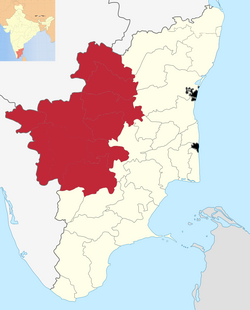| Kongu Tamil | |
|---|---|
| கொங்கு தமிழ் | |
| Pronunciation | Koṅku Tamil |
| Native to | West part of Tamil Nadu and some parts of Karnataka, Kerala |
| Region | Kongu Nadu |
| Ethnicity | Kongu Vellalar |
Native speakers | (undated figure of ~25 million [ citation needed ]) |
Early forms | |
| Tamil script | |
| Official status | |
Official language in | |
| Language codes | |
| ISO 639-3 | – |
| Glottolog | None |
 Distribution of native Tamil speakers in India and Sri Lanka | |
Kongu Tamil or Kovai Tamil (also called Kongalam, Kongu Pechu, Coimbatore Tamil) is the dialect of Tamil language that is spoken by the people in Kongu Nadu, which is the western region of Tamil Nadu. It is originally known as "Kangee"` [1] or "Kongalam" [2] or "Kongappechu or Kongu bashai or Coimbatore Tamil".
